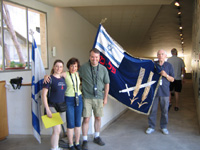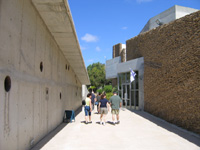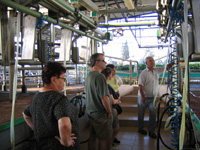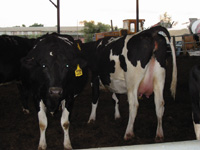Day 7 - Sunday 9/18/05
Palmach Museum
After a good night's sleep in our own Rechovot beds, and one of Shula's elaborate breakfasts, we were ready for the third of our scheduled museum adventures -- the Palmach Museum in Tel Aviv. From their brochure: "The Palmach Museum is an experiential museum, covering the Palmach legacy through the stories of individuals and groups. Visitors to the museum join the group of young Palmach recruits from its establishment, and advanced through the story of the Palmach until the end of the War of Independence. The manner of presentation is extremely innovative. There are no displays or documents, but rather an account of a fascinating personal story accompanied by three-dimensional decor, films and various effects incorporating documentary materials. The Palmach [acronym for 'Plugot Hamahatz' -Striking Force] Units were established as part of the "Hagana" underground organization in May 1941. The Palmach was not merely a military organization - it was the way of life of social organization, based on the values of pioneering settlement. The Palmach bases were situated in many kibbutzim. The Palmach members participated in military training exercises alongside their agricultural chores, and created a social framework that was perceived as the core essence of the Sabra [native born Israeli]. The height of the Palmach activity was during the War of Independence in Israel, from November 1947 until March 1949, where they constituted the "Tip of the Spear" during the war and in the establishment of the Israeli Defense Force." John and I really enjoyed this presentation and thought it was very well done (though it was definitely the loudest museum we had ever been to). It was also interesting to hear my parents' stories of their involvement during the war - that children on bicycles were used as messengers to army units, and that they remembered being woken by their parents to dance with joy in the streets when the vote establishing a State of Israel was read on the radio. At one point, my mother pointed at a photo of a woman holding a huge rifle and reminisced that this particular Czechoslovakian weapon was what she was issued in boot camp - she remembered the huge bruises on her shoulder from the recoil when firing it. She went on to tell us that half way through training they were relieved to exchange their Czech rifles for Uzis, which were more reliable and much easier to break down to clean (only 4 pieces she remembered happily).
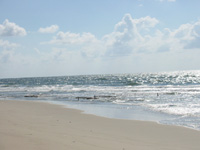
Tel Aviv Promenade
Lunch was on the Tel Aviv Promenade, at a different restaurant than our previous dinner, and we were treated to a daytime view of the Mediterranean.
Moshav Be'er Tuvia
Our next stop was Moshav Be'er Tuvia where Shula grew up, to visit Dola and Miriam, friends of hers who own the most modern dairy in the entire country of Israel, and one of only four like it in the world. The entire process is computerized, and the machine tracks the health and output of the animals as well as the analysis of the milk produced. The cows receive only clean organic feed, no hormones, and the waste is processed into fertilizer without contaminating the water table. We were told that a good European cow produces 35 - 45 gallons of milk per day, but that a good Israeli cow produces up to 65 gallons per day, and that the resulting output is of higher quality and richer in butterfat. It was a fascinating visit and afterwards we were invited to their home for a meal.
| Copyright © 2005 by Oreet Herbst and John Knott |
